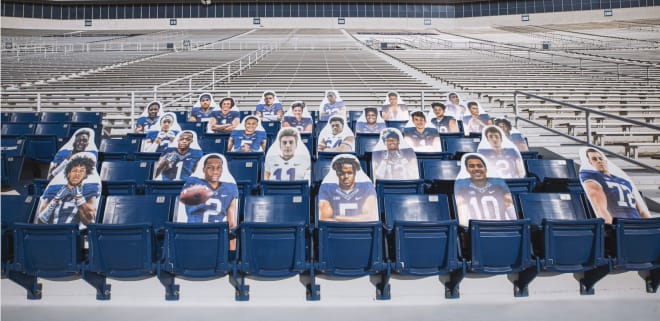Recruiting: Three ways to analyze Penn State's Class of 2021
Penn State may rank 26th overall, but the talent they signed suggests that this year's class isn't much different to previous years
This year's recruiting class will go down as the worst under head coach James Franklin, but with just 16 players signed, it's also the smallest under Franklin's leadership, too.
For those unfamiliar with Rivals' system, only the top 20 players for each team are counted, ensuring that the biggest classes don't automatically rise to the top. It also uses a bonus point system for the players that make the Rivals250. If you land the No. 1 player in the country, you'll receive 250 points for that player alone. Land No. 248 and you'll earn 108 points for that player. Those outside the Rivals250 can earn you anywhere from 105 points to just 15.
This system does a good job at balancing both quantity and quality, but it also allows for a few outliers every year that rank substantially lower than the talent deserves. Penn State is one of those schools this year, but before we get into that, let's take a look at this year's top 40 teams, while also comparing average star rating and average points per player.
Note: Rankings as of 5:00 p.m. ET on Feb. 3

| Rivals Team Rankings | Total Commits (Total Points) | Average Star Rating (Ranking) | Average Points Per Player (Ranking) |
|---|---|---|---|
|
1) Alabama |
26 (3,478) |
4.04 (1st) |
133.76 (5th) |
|
2) Ohio State |
21 (2,988) |
4.0 (2nd) |
142.28 (1st) |
|
3) Oregon |
23 (2,726) |
3.87 (5th) |
118.52 (6th) |
|
4) Texas A&M |
23 (2,721) |
3.83 |
118.30 (9th) |
|
5) LSU |
22 (2,688) |
3.86 (6th) |
122.18 (7th) |
|
6) Georgia |
20 (2,677) |
3.85 |
133.85 (4th) |
|
7) Clemson |
19 (2,669) |
3.95 |
140.47 (2nd) |
|
8) USC |
22 (2,646) |
3.82 (T-8th) |
120.27 (8th) |
|
9) Michigan |
23 (2,447) |
3.57 (11th) |
106.39 (12th) |
|
10) Notre Dame |
27 (2,382) |
3.44 (T-15th) |
88.22 (21st) |
|
11) Florida |
22 (2,353) |
3.55 (13th) |
102.95 (13th) |
|
12) Miami |
21 (2,332) |
3.62 (10th) |
111.04 (10th) |
|
13) Oklahoma |
16 (2,166) |
3.88 (4th) |
135.37 (3rd) |
|
14) Wisconsin |
21 (2,027) |
3.48 (14th) |
96.52 (15th) |
|
15) Texas |
21 (2,010) |
3.38 (18th) |
95.71 (16th) |
|
16) Tennessee |
21 (2,009) |
3.33 (19th) |
95.66 (17th) |
|
17) N. Carolina |
18 (1,921) |
3.56 (12th) |
106.72 (11th) |
|
18) Ole Miss |
25 (1,856) |
3.24 (T-21st) |
74.24 (36th) |
|
19) Nebraska |
20 (1,845) |
3.15 (28th) |
92.25 (18th) |
|
20) Maryland |
23 (1,702) |
3.09 (T-34th) |
74 (37th) |
|
21) Missouri |
22 (1,677) |
3.18 (27th) |
76.22 (33rd) |
|
22) Pitt |
23 (1,644) |
3.09 (T-34th) |
71.47 (41st) |
|
23) Miss. State |
22 (1,614) |
3.23 (24th) |
76.85 (32nd) |
|
24) Iowa |
19 (1,609) |
3.21 (T-25th) |
84.68 (23rd) |
|
25) Arkansas |
22 (1,604) |
3.09 (T-34th) |
72.9 (40th) |
|
26) Penn State |
16 (1,578) |
3.44 (T-15th) |
98.62 (14th) |
|
27) Louisville |
22 (1,530) |
2.95 (46th) |
69.54 (43rd) |
|
28) Florida State |
17 (1,505 |
3.24 (T-21st) |
88.52 (20th) |
|
29) Virginia |
24 (1,500) |
3.04 (43rd) |
62.5 (47th) |
|
30) Boston College |
26 (1,492) |
2.92 (50th) |
57.38 (49th) |
|
31) UCLA |
18 (1,487) |
3.11 (T-32nd) |
82.61 (25th) |
|
32) Kentucky |
18 (1,438) |
3.11 (T-32nd) |
79.88 (28th) |
|
33) Vanderbilt |
22 (1,425) |
3.0 (T-44th) |
64.77 (46th) |
|
34) Utah |
17 (1,413) |
3.24 (T-21st) |
83.11 (24th) |
|
35) Cincinnati |
25 (1,410) |
2.68 (T-64th) |
56.4 (50th) |
|
36) Rutgers |
21 (1,402) |
2.9 (T-52nd) |
66.76 (45th) |
|
37) Michigan St. |
19 (1,401) |
3.0 (T-44th) |
73.7 (38th) |
|
38) Minnesota |
17 (1,395) |
3.06 (T-40th) |
82.05 (27th) |
|
39) California |
19 (1,393) |
3.05 (42nd) |
73.31 (39th) |
|
40) Kansas |
22 (1,391) |
2.91 (51st) |
63.22 (48th) |
There are a lot of numbers there, so I highlighted a few classes that stand out to me.
The first would be Oklahoma's class, which ranks down in 13th but clearly has the talent that ranks among the nation's best programs. With three five-star players and eight four-star prospects, all of whom sit inside the Rivals250, it shows just how much quantity impacts the overall ratings. I don't think too many people would argue that Oklahoma's quality this year doesn't rank up there with some of the best in the country.
Notre Dame's class also stands out. The Irish signed 27 players this year, which is good for 10th overall, but if you look at the averages, it suggests that the Irish don't have quite the quality as many of the schools around them. Those numbers - 3.44 average stars & 88.22 points per player - rank 15th and 21st, respectively. It's a great class that Notre Dame fans should be happy with, but it also averages out to pretty much the same numbers that Penn State did this year. Yet, if you asked fans from each fan base about their school's respective class, I think you'd hear very different answers.
That brings me to the Nittany Lions. 10 of the 12 teams that rank directly ahead of Penn State are there for their quantity more so than their quality. No. 17 North Carolina and No. 14 Wisconsin average out about the same, but that's it. Local rivals Maryland and Pitt will both be recognized as having a better class than Penn State this year, yet their average points per player of 74.0 and 71.47 would be Franklin's lowest ever since taking over the program. I'm not saying their classes aren't good (personally, I think a few of Pitt's players are underrated) but I know many of you wouldn't accept those averages at Penn State.
Speaking of Penn State's averages, the 98.62 points per player average is the fourth best under Franklin's leadership. For some perspective, the 2018 class was their top overall class with a 117.91 average, while last year's Class of 2020 was the lowest (80.07). I don't include 2014 because Franklin and his staff were only on campus for a few weeks.
None of this is to say that the current ranking system isn't the proper way to rank 100 Football Bowl Subdivision programs, but rather that there are different ways to judge a class. This year's Penn State class will be remembered for some of the misses by many of you, and even Franklin himself would tell you that players like Nolan Rucci and Derrick Davis can't get away. With that said, there's also a mindset among many in the fan base that this class is a major step back compared to previous years, when it reality, it's not all that much different. In fact, you can argue that this year's class is more talented than last year's class. It all just depends on how you want to look at it.
| Rivals Team Rankings | Total Commits (Total Points) | Average Star Rating (Ranking) | Average Points Per Player (Ranking) |
|---|---|---|---|
|
42) Washington |
15 (1,369) |
3.4 (17th) |
91.26 (19th) |
|
46) West Virginia |
16 (1,313) |
3.25 (20th) |
82.06 (26th) |
|
47) Ga. Tech |
16 (1,260) |
3.13 (T-30th) |
78.75 (29th) |
|
50) Auburn |
14 (1,228) |
3.21 (T-25th) |
87.71 (22nd) |
|
53) Northwestern |
16 (1,202) |
3.06 (T-40th) |
75.12 (35th) |
|
56) Arizona State |
15 (1,163) |
3.13 (T-30th) |
76.13 (30th) |
|
62) Indiana |
14 (1,083) |
3.07 (39th) |
77.35 (31st) |
|
64) TCU |
14 (1,065) |
3.14 (29th) |
76.07 (34th) |
|
T-78) Texas Tech |
13 (915) |
3.08 (T-37th) |
70.38 (T-42nd) |
|
T-78) S. Carolina |
13 (915) |
3.08 (T-37th) |
70.38 (T-42nd) |
I threw this table in just to compare where Penn State ranks compared to a few other schools that signed a similar number of recruits. What's interesting to me about these schools is that most of them took a similar approach to Penn State this year when it comes to being aggressive in the transfer portal. Georgia Tech has already added seven transfers, while Texas Tech has added six and Oklahoma has added five. Only Auburn, Washington and West Virginia have less than three transfers added. Most importantly, I contacted colleagues at all but two of those schools, and every one of them said that their respective school would still like to add via the portal in the months ahead.
This is something that I think we're only going to see more of in the year's to come. With schools putting a bigger emphasis on the transfer portal, more and more programs are going to sign less than 20 players every year. Franklin and his staff always planned to add a few transfers this year due to the lack of high school scouting, which is why 18 was always the number we stressed in regards to the maximum amount of high school prospects. It ended up being a few more transfers than they originally planned, and more still are likely to come. A few years ago, Penn State would've signed 20 or so high school prospects rather than 16. This will be a trend that certainly impacts recruiting rankings in the years to come.
*******
• Talk about this article inside The Lions Den
• Watch our videos and subscribe to our YouTube channel
• Learn more about our print and digital publication, Blue-White Illustrated
• Follow us on Twitter: @BWIonRivals, @NateBauerBWI, @RivalsSnyder, @DavidEckert98
• Like us on Facebook
